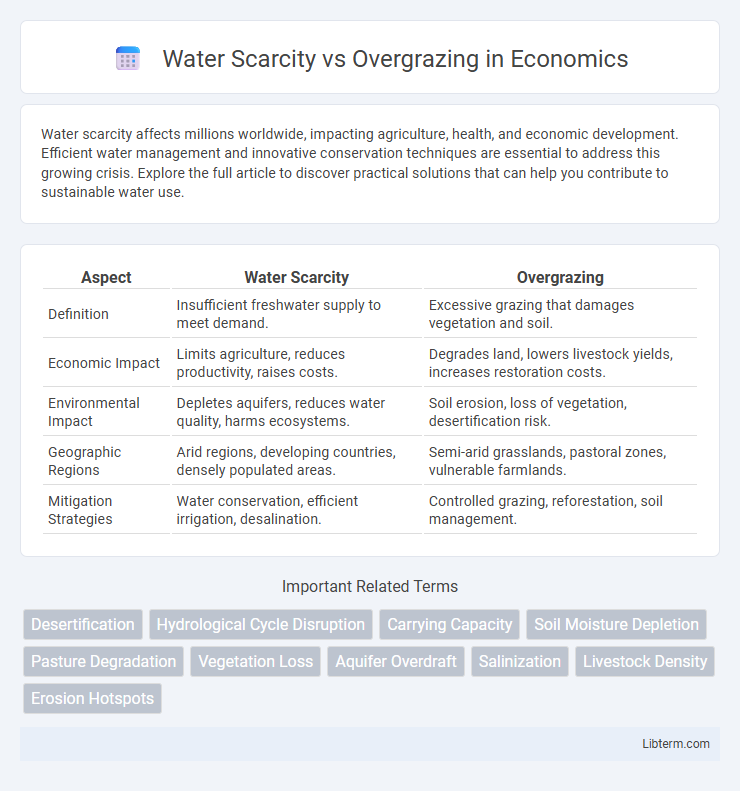Water scarcity affects millions worldwide, impacting agriculture, health, and economic development. Efficient water management and innovative conservation techniques are essential to address this growing crisis. Explore the full article to discover practical solutions that can help you contribute to sustainable water use.
Table of Comparison
| Aspect | Water Scarcity | Overgrazing |
|---|---|---|
| Definition | Insufficient freshwater supply to meet demand. | Excessive grazing that damages vegetation and soil. |
| Economic Impact | Limits agriculture, reduces productivity, raises costs. | Degrades land, lowers livestock yields, increases restoration costs. |
| Environmental Impact | Depletes aquifers, reduces water quality, harms ecosystems. | Soil erosion, loss of vegetation, desertification risk. |
| Geographic Regions | Arid regions, developing countries, densely populated areas. | Semi-arid grasslands, pastoral zones, vulnerable farmlands. |
| Mitigation Strategies | Water conservation, efficient irrigation, desalination. | Controlled grazing, reforestation, soil management. |
Understanding Water Scarcity: Key Drivers
Water scarcity is primarily driven by factors such as population growth, climate change, and inefficient water management, which reduce the availability of fresh water resources for human and agricultural use. Overgrazing exacerbates water scarcity by causing soil degradation and reducing vegetation cover, leading to decreased soil moisture retention and increased runoff. Effective strategies to address water scarcity must consider the interplay between human activities like overgrazing and environmental changes impacting water cycles.
What Is Overgrazing? Causes and Consequences
Overgrazing occurs when livestock feed on vegetation faster than it can naturally regenerate, leading to soil degradation and loss of plant biodiversity. Major causes include excessive livestock density, poor land management practices, and prolonged drought conditions that reduce forage availability. The consequences of overgrazing include increased soil erosion, reduced agricultural productivity, desertification, and exacerbated water scarcity due to diminished vegetation cover impacting the water cycle.
The Interconnectedness of Water Scarcity and Overgrazing
Water scarcity and overgrazing are interconnected environmental challenges where limited water resources exacerbate vegetation loss caused by excessive grazing. Overgrazing reduces plant cover, leading to soil erosion and decreased water retention capacity, which intensifies water scarcity in affected regions. This cyclic relationship disrupts ecosystems, impairs agricultural productivity, and threatens sustainable land management.
Environmental Impacts of Water Shortages
Water scarcity intensifies soil degradation by reducing moisture necessary for plant growth, leading to diminished vegetation cover and increased vulnerability to erosion, which overgrazing further exacerbates by stripping protective plant layers. The combined effect accelerates land desertification and disrupts local hydrological cycles, decreasing groundwater recharge and contributing to habitat loss for wildlife. This synergy between water shortages and overgrazing undermines ecosystem resilience and threatens agricultural productivity in arid and semi-arid regions.
How Overgrazing Exacerbates Water Scarcity
Overgrazing depletes vegetation cover, leading to soil erosion and reduced water infiltration, which diminishes groundwater recharge and surface water availability. The loss of plant roots decreases soil stability, causing runoff to increase and water retention in the ecosystem to decline. Consequently, water scarcity intensifies as ecosystems struggle to retain moisture and support sustainable water cycles.
Socioeconomic Effects: Rural Communities at Risk
Water scarcity and overgrazing critically impact rural communities by reducing agricultural productivity and limiting access to essential resources, leading to increased poverty and food insecurity. The degradation of land due to overgrazing accelerates soil erosion and diminishes water retention, worsening water shortages and reducing crop yields. These intertwined challenges threaten livelihoods, heighten migration pressures, and strain local economies dependent on farming and livestock.
Sustainable Grazing Practices to Combat Water Scarcity
Sustainable grazing practices like rotational grazing and controlled stocking rates reduce soil erosion and enhance vegetation cover, improving water retention in arid regions. Implementing drought-resistant forage species and restoring degraded rangelands support groundwater recharge and maintain ecosystem resilience. These strategies mitigate water scarcity by balancing livestock needs with preserving vital water resources and land productivity.
Policy Solutions for Managing Land and Water Resources
Effective policy solutions for managing land and water resources address the intertwined challenges of water scarcity and overgrazing by promoting sustainable land use practices, such as rotational grazing and reforestation, which enhance soil moisture retention and reduce erosion. Implementing integrated water management policies, including rainwater harvesting and efficient irrigation techniques, optimizes water availability for both agricultural and ecological needs. Strengthening regulatory frameworks that incentivize sustainable resource use and support community-based management ensures long-term resilience against the adverse impacts of these environmental stressors.
Innovations in Water Conservation for Grazing Lands
Innovations in water conservation for grazing lands address the critical challenges caused by water scarcity and overgrazing through efficient irrigation technologies like drip and subsurface irrigation, which reduce water loss and improve soil moisture retention. Use of smart sensors and remote monitoring systems enables precise water application tailored to the needs of vegetation, preventing degradation and promoting sustainable forage production. Integration of rainwater harvesting and constructed wetlands enhances water availability while maintaining ecosystem balance and supporting livestock resilience in arid and semi-arid regions.
Future Outlook: Building Resilience Against Water Scarcity and Overgrazing
Future outlook for building resilience against water scarcity and overgrazing emphasizes integrated land and water management strategies that enhance soil health and optimize water use efficiency. Incorporating drought-resistant vegetation and sustainable grazing practices supports ecosystem stability and reduces land degradation risks. Advances in remote sensing and data analytics enable precise monitoring and adaptive interventions to mitigate impacts of climate change on vulnerable regions.
Water Scarcity Infographic

 libterm.com
libterm.com